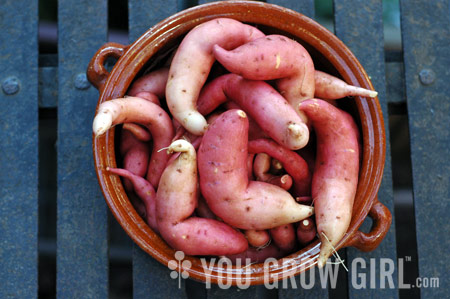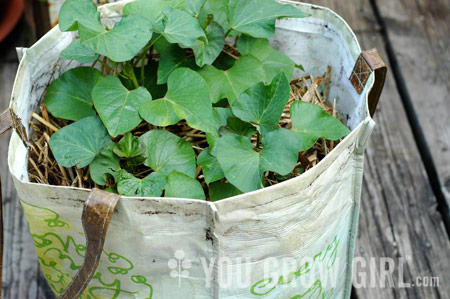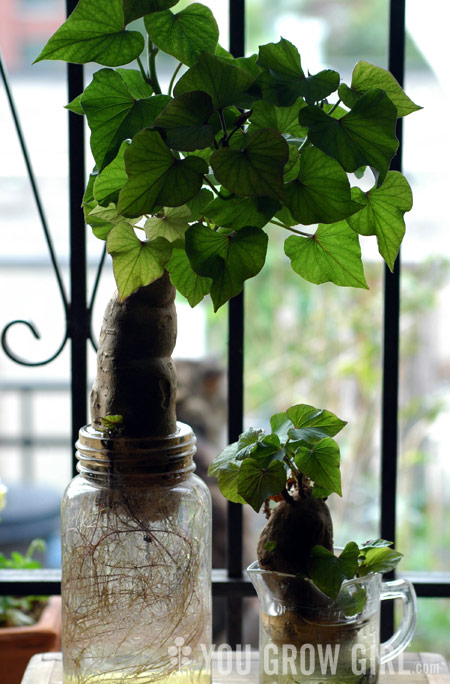Happy Planting!
 I have put together how to plant, grow and harvest sweet potatoes in a few different way's for you. I know you will find one of these ways will be just right for you to be serving fresh sweet potatoes out of your own garden for the holidays! Enjoy...
I have put together how to plant, grow and harvest sweet potatoes in a few different way's for you. I know you will find one of these ways will be just right for you to be serving fresh sweet potatoes out of your own garden for the holidays! Enjoy...Step 1: Start the Slips
Sweet potatoes aren't started by seed like most other vegetables, they're started from slips. Slips are shoots that are grown from a mature sweet potato. You can order slips from a mail order or Internet catalog or you can start slips from a sweet potato you bought at the store or one from your garden. If you buy a potato from the store, be sure to find out if you're getting a bush type or a vining type.To start your slips, you need several healthy, clean sweet potatoes. Each sweet potato can produce up to 50 slip sprouts. To create sprouts, carefully wash your potatoes and cut them either in half or in large sections (Image 1). Place each section in a jar or glass of water with half of the potato below the water and half above. Use toothpicks to hold the potato in place (Image 2).
The slips need warmth, so put them on a window ledge or on top of a radiator. In a few weeks your potatoes will be covered with leafy sprouts on top and roots on the bottom (Image 3).
Step 2: Root the Slips
Once your sweet potatoes have sprouted, you have to separate them into plantable slips. To do this, you take each sprout and carefully twist it off of the sweet potato. Take each sprout and lay it in a shallow bowl with the bottom half of the stem submerged in water and the leaves hanging out over the rim of the bowl. Within a few days roots will emerge from the bottom of each new plant. When the roots are about an inch long the new slips are ready to plant. To keep your slips healthy be sure to keep the water fresh and discard any slip that isn't producing roots or looks like it's wilting.Step 3: Prepare the Soil for the Slips
Before you plant sweet potato slips, you have a little extra work to do. Sweet potatoes need loose, well-drained soil to form large tubers. You don't want the roots to face resistance when they try to expand within the soil. Loose soil is more critical than almost any other factor when it comes to growing sweet potatoes successfully.Step 4: Plant the Slip
Using a small hand trowel, dig a hole about 4" or 5" deep and 3" wide. Place one slip in each hole with the roots pointing down. Position the slip so that the bottom half will be covered with dirt while the top half with all of the new leaves is above ground.Carefully fill the hole with dirt so that you don't bruise the new plant. Sweet potatoes don't like to be bruised or bumped around too much. When you have completely covered it with soil, gently press the plant and surrounding dirt to set the plant and to remove any remaining air pockets. Continue the same way until all of your slips are planted.
Step 5: Water, Water, Water
Once all of the slips are in place water them. You'll need to give them a thorough soaking until all of the surrounding dirt is wet. Stop watering before your mound starts to erode. New plants, like slips, need to be watered everyday for the first week and every other day the second week. Each week the watering will get a little farther apart until you're watering once a week. If the ground is very dry or you've had a lot of rain, you may need to adjust this schedule in your own garden. Sweet potatoes can withstand drought but they'll produce less, so make sure you water them during the hottest part of the summer.
Growing Sweet Potatoes in a Bag

My most recent Globe and Mail Kitchen Gardening article is on sweet potatoes and chronicles an experiment I took up by chance, growing sweet potatoes in a shopping bag.
While in Dominica I learned that when there is not enough soil fertility to produce tubers, sweet potato leaves are cooked or steamed like spinach. I haven’t tried it yet, but think this would be a good option when starting the plant too late in the growing season. I have some slips on hand right now that I might plant for this reason.
————————–
Like most rabid gardeners, I spend the winter months concocting elaborate fantasy versions of my inadequately undersized growing spaces. When it comes down to what goes into the soil at planting time, however, happenstance seems to rule the day. I don’t plan my gardens; they plan themselves.
And I wouldn’t have it any other way. Some of my most exciting growing experiences and experiments have come about by chance. Take sweet potatoes (Ipomea batata) as an example. I’d been growing regular potatoes for ages, but had avoided the tropical, super-sweet tuber. Mention growing them and gardeners go grim. “Forget it. Our season isn’t long enough,” they cry. “And the damn things take up too much space.”
They are right. Sweet potatoes require a notoriously long growing season — about 100 to 140 days to be exact. And unlike regular potatoes, their meandering, snaking vine grows like a giant’s intestines. In my tight confines, the odds seemed against me, so I acquiesced until a tuber bought at the local farmers’ market sprouted on top of my fridge and forced my hand. How could I not try to grow it? But where would I put it?

All of my pots and bed space were accounted for and I simply refused to go out of my way for a plant that wasn’t on the agenda and might not produce. That’s when I thought of grow bags. British gardeners have been successfully growing in soil-filled bags for years. Grow bags from pre-filled poly versions to reusable cloth bags are now used to grow all manner of crops that are tricky to keep alive in the ground. So why not dump some potting soil, I thought, into one of the stacks of over-sized green tote bags I’ve collected over the years and call it a “grow bag.”
Here’s how I went about it.
Big tubers need lots of soil space to grow, so use the largest tote bag you can find or sew one yourself using breathable landscaping cloth. My bag was not cloth so I cut holes into the bottom and some into the sides to create good drainage; if you don’t do this, your plants will rot. Fill the bags with well-draining potting soil, not soil dug out of the garden.

The plants themselves are produced from cuttings called slips. You can make an unlimited number of slips yourself from a single sweet potato purchased from a market or organic food store. Start making them in early spring — about a month before the last frost in your area — so you can meet the plants’ long-season demands. Simply stand the potato in a jar of water so that about a third to a half is submerged in the water. Set it in a sunny windowsill where it will form little shoots and leaves within a few weeks. When the shoots are about six inches long, carefully twist or “slip” them off of the potato. Some gardeners put these slips into water or very wet sand to produce roots before planting; I, however, have placed the rootless slips directly into soil with success. The trick is to keep the soil moist (not soggy) and the bag or pot out of the hottest sun until the plants are established. About two or three slips is all you need for a typical tote bag. Don’t forget that sweet potatoes are a tropical that do not like cold weather or frost. Wait until well after all danger of frost in your area has passed before setting the plants outdoors.
And that’s it. For all the fuss, they really are an easy crop to grow. And pretty too. Even the boring varieties will produce lush, tumbling green vines with flushes of purple in the newest growth. Colorful, ornamental varieties produced for the annual plant market are also edible. You may have noticed tubers in your own pots and hanging baskets at the end of a particularly warm growing season — eat them or save them for next year’s plants. Unfortunately, ornamentals are not as productive as those grown for food so you are better off with the regular varieties if you want a good crop.
Just before the first frost, turn the bag over onto a plastic sheet or dig out the tubers. I got four pounds. Not bad for a crop that cost me nothing and I had never intended to grow.
Helpful and Entertaining Videos
How to start a plant with
Plant clippings
How to start a Sweet Potato
From start to harvest
Harvesting from a bag
Harvesting from Containers







thank you so much for these wonderful idea; I put sweet potatoes on my grocery list so I can save one tuber for growing my own slips.
ReplyDelete